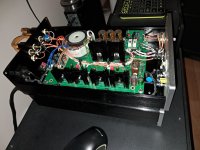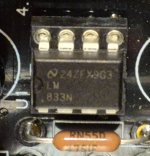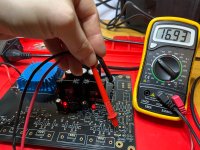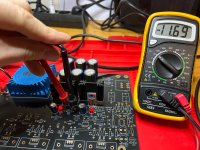Everyone is waiting for YOU to do an FFT for the harmonic content.
Without your contribution, people won't be able to decide whether to build a WHAMMY or move on to other alternatives.
Without your contribution, people won't be able to decide whether to build a WHAMMY or move on to other alternatives.
I wasn’t knocking anything I was just curious as to an FFT.
Meant no harm. Or if you think I’m part of the silly ASR crew.
Cheers
Meant no harm. Or if you think I’m part of the silly ASR crew.
Cheers
https://forum.headphones.com/t/pass-labs-whammy-solid-state-class-a-headphone-amp-kit/5272
Someone here has measured and has a bar graph fft. They also have other measurements of distortion with different op amps.
The distortion at non deafening levels is typically triple zero something %.
Someone here has measured and has a bar graph fft. They also have other measurements of distortion with different op amps.
The distortion at non deafening levels is typically triple zero something %.
Can the amp run with BJTs instead of Mosfets and would the correct changes be done as the below instructions state?
Much appreciated!

Much appreciated!
Yes.Can the amp run with BJTs instead of Mosfets
This is the distortion profile in simulation with first FET and then BJT + mods. It could be argued the BJT version is fractionally better although the reality is the simulated result differences are half of a quarter of nothing 😀
Can the amp run with BJTs instead of Mosfets
absolutely and practically no changes needed in surrounding circuitry, but better not...... speaking from technical point of view
mosfets (be it Toshibas or plain IRF) are much easier load for opamp
though, it can be fun - try it both ways and use what you like more
Yes.
This is the distortion profile in simulation with first FET and then BJT + mods. It could be argued the BJT version is fractionally better although the reality is the simulated result differences are half of a quarter of nothing 😀
View attachment 1436800
View attachment 1436802
Ha, that’s pretty funny.
What are the sound differences ? Classic MOSFET vs. BJT sound differences? mosfets a bit warmer and fuller and BJT faster ?
From those graphs it looks like there was no difference in sound.
Thanks for the replies
Last edited:
mosfets (be it Toshibas or plain IRF) are much easier load for opamp
Perhaps builders can avoid this by carefully selecting BJTs which present an extremely light load to the opamp. Maybe BJT-enthusiastic WHAMMY builders might want to carefully research
2SC6144SG: NPN, TO-220 isolated tab, 50V max, 10A max, 25W max, min Beta= 200 (max=500), fT= 330 MHz
2SA2222SG: PNP, TO-220 isolated tab, 50V max, 10A max, 25W max, min Beta= 150 (max=450), fT= 230 MHz
This is neither a recommendation nor an offer of ongoing technical training & support; it's simply a Hey Maybe Take A Look And See What YOU Think About This Shiny Object
What are the sound differences ? Classic MOSFET vs. BJT sound differences? mosfets a bit warmer and fuller and BJT faster ?
I've never built or even listened to one 🙂 but given the low output levels and relatively high load impedances I think there will be no real audibly discernable differences imo.
Germanium could be an interesting option 😉 You need to listen for yourself and make your own mind up.
AD161/162
Here is my copy of the Whammy in action. Compared to the previous one, I have Toshiba 2SJ313/2SK2013 at the output, the opamp is Burson V7 Classic, the rest is more or less the same, including the box. Mute+DC protection are default. Power supply is +-15V (7815/7915 ACTG). Burson is stable, it does not need compensation. The same is true for the OPA2604 and NE5532. I haven't tried the others. I'd like to keep the Burson, but there will be a sound test with other opamps.
Attachments
What opamp would you recommend for Whammy if I would like to have a bit more punch in the kickdrum and a bit more grunt on heavy electric guitar?
I now use LM833 and its a slightly light on those areas.
I now use LM833 and its a slightly light on those areas.
I don't know, I've never had an LM833 to compare it to any other opamp. Try OPA2604, OPA1656, OPA1642A.
The LM833 was and still is an excellent device although bizarrely two quite different versions of it exist, the original with the complementary output stage and also a version with a quasi complementary stage.
Perhaps @LeroyVynil might actually prefer something like a TL072 which would be very lightly loaded in this application.
Perhaps @LeroyVynil might actually prefer something like a TL072 which would be very lightly loaded in this application.
As we chat I stick the Signetics NE5532 into the Whammy. By far the best bass I've heard from the Whammy. The highs are not too sharp, in a strange way it suits him. Bought second-hand from the Chinese. Plucked from who knows what device.
Which version is this?The LM833 was and still is an excellent device although bizarrely two quite different versions of it exist, the original with the complementary output stage and also a version with a quasi complementary stage.
Perhaps @LeroyVynil might actually prefer something like a TL072 which would be very lightly loaded in this application.
Attachments
I accidentally ordered the signetics NE5534, planning on joining 2 of them to see what all this fuss is aboutAs we chat I stick the Signetics NE5532 into the Whammy. By far the best bass I've heard from the Whammy. The highs are not too sharp, in a strange way it suits him. Bought second-hand from the Chinese. Plucked from who knows what device.
They are good. I always hated the 5532/5534 because I only had the TI version. 😁I accidentally ordered the signetics NE5534, planning on joining 2 of them to see what all this fuss is about
You just have to compensate them probably. They are not as stable as the 5532.
- Home
- Amplifiers
- Pass Labs
- "WHAMMY" Pass DIY headphone amp guide




